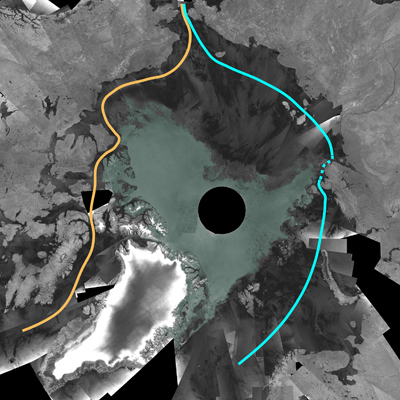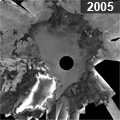The area covered by sea ice in the Arctic has shrunk to its lowest level since satellite measurements began nearly 30 years ago, opening up the Northwest Passage – a long-sought short cut between Europe and Asia that has been historically impassable.
In the mosaic image above, created from nearly 200 images acquired in early September 2007 by the Advanced Synthetic Aperture Radar (ASAR) instrument aboard ESA’s Envisat satellite, the dark gray color represents the ice-free areas while green represents areas with sea ice.
Leif Toudal Pedersen from the Danish National Space Centre said: “We have seen the ice-covered area drop to just around 3 million sq km which is about 1 million sq km less than the previous minima of 2005 and 2006. There has been a reduction of the ice cover over the last 10 years of about 100 000 sq km per year on average, so a drop of 1 million sq km in just one year is extreme. To give you an idea of how big 1 million sq km is that is about 386,000 sq miles, or 1.5 times the size of Texas.
With melting this year 10 times the average are we experiencing the tipping point? The tipping point would be when there is enough dark ocean water not covered with white reflective ice that the amount of heat absorbed would make it impossible for ice to reform. It is extremely hard to calculate just when this point will happen, but we can imagine what the results of such a scenario would be.
The first thing we would notice is a rapid, and out of control melting (see above), this would be because as more ice melts, more heat is absorbed, which melts more ice, which allows more heat to be absorbed, which melts more…you get the idea. The second thing we would notice is that the ice that did form this winter would not extend as far as previous years (we will have to wait to see this data as the ice usually continues to melt until mid/late September). If the ice does fail to recover this winter it means that all winter long the water exposed to the sun will be kept at a higher temperature than it normally would and next summer the ice will melt that much faster.
“The strong reduction in just one year certainly raises flags that the ice (in summer) may disappear much sooner than expected and that we urgently need to understand better the processes involved.”
Arctic sea ice naturally extends its surface coverage each northern winter and recedes each northern summer, but the rate of overall loss since 1978 when satellite records began has accelerated.
The most direct route of the Northwest Passage (highlighted in the top mosaic by an orange line) across northern Canada is shown fully navigable, while the Northeast Passage (blue line) along the Siberian coast remains only partially blocked. To date, the Northwest Passage has been predicted to remain closed even during reduced ice cover by multi-year ice pack – sea ice that survives one or more summers. However, according to Pedersen, this year’s extreme event has shown the passage may well open sooner than expected.
The previous record low was in 2005 when the Arctic area covered by sea ice was just 4 million sq km. Even then, the most direct Northwest Passage did not fully open.
The Polar Regions are very sensitive indicators of climate change. The UN’s Intergovernmental Panel on Climate Change showed these regions are highly vulnerable to rising temperatures and predicted the Arctic would be virtually ice free by the summer of 2070. Still other scientists predict it could become ice free as early as 2040 due to rising temperatures and sea ice decline.
click for larger animation above.
The prospect of a warm arctic, is in short not a good one. Not good for polar bears, not good for the people who live in the arctic, and even though they think it would be a gold rush, not good for industrialized countries either.
If this is the tipping point, it might be a little late to do much. But if this is just a small taste of things to come, well we still have some time. Quick direct action to lower CO2 emissions will make progress towards healing this problem. Things are starting to get pretty serious. I wonder will we start to act?


It’s frustrating sometimes to get a big company like Google to do the right thing. This is a case in point. The Earth needs a year by year awareness of the melting Arctic ice cap. Yet Google refuses to show it to us. The excuse goes something like “we only show images of land masses and the artic is not a land mass”. The fix is easy … change that rule for the Arctic … there are plenty of sources of imagery available to Google.
I fear that we are entering the “tipping point” of the Arctic ice sheet.
If you look at this graph from Cryosphere Today.
http://arctic.atmos.uiuc.edu/cryosphere/IMAGES/seasonal.extent.1900-2007.jpg
You’ll see a reducing trend in extent from 1950, it’s slight in all seasons but stronger in summer. That’s because of ice-albedo feedback as you desrcibe – water mainly absorbs sunlight, ice (being white ) mainly mainly reflects. As you go from ice to ocean some there’s an increase of about 60% of the available sunlight being absorbed. So this effect amplifies the summer warming. But that slight trend appears to be accelerating in the last few years.
The Arctic Oscillation (AO) is a vortex of air over the Arctic, the Antractic has one too. In the 1990s the Arctic Oscillation began to change it’s ‘index’ from a mixed positive and negative to a mainly positive index. That mostly began the loss of perrenial ice (ocean temperature also had a role), but since then there’s been an ongoing loss of old ice. If you look at NSIDC here
http://nsidc.org/news/press/2007_seaiceminimum/20070810_index.html
scroll down the page to 22 August and look at the animated gif at figure 4 down below that heading. You’ll see what’s happened to the multi-year or perennial ice, it’s dwindled from a central mass to a far smaller core, the red area shows it well that’s ice over 5 years old. Also on that page under 28 August 2007, figure 3 is the graph forced me to accept that we could be on a tipping point. I’ve been in a daze since then.
The significance of the old perennial ice is that it’s a damping factor on the behaviour of the ice sheet. The perennial ice takes longer to melt so cools the region by reflecting sunlight back into space. It sticks around during the summer longer, and in the winter it allows much less heat through from the sea than does 1 year ice. So it acts as a physical mechanism that averages out the ravages of the summers ice albedo effect enhanced melt.
What’s happened is that in the midst of a warming trend we’re losing the damping (averaging) factor that stops the ice albedo effect from running away. It was reported yesterday that International Polar Year researchers have found a 50% reduction in ice thickness in the last few years.
However I am less worried about Polar Bears than I am about global warming and northern hemisphere depression tracks. Because it’s white the ice-cap keeps the Arctic a lot cooler than it otherwise would be. The ice also insulates the ocean from the atmopshere – allowing colder temperatures in the atmosphere. The equator is a lot warmer than the poles, so the atmosphere acts as a heat engine, converting the pole-equator temperature difference into atmospheric and oceanic movement. We get seasons with the Earth’s orbit around the Sun, here in the UK those seasons aren’t just warm/cool, we get different weather as the jet stream responds. In a similar way if you change the pole-equator temperature difference as the summer ice vanishes year after year, you change the behaviour of the ocean/atmosphere heat engine. I don’t know what if any effect such a climatic shift might have, as far as I can see it’s not been looked into, it was not thought a realitic prospect.
For such a shift to happen in decades is worrying, obviously you’ll still have winter ice, and it would not be a swift move to no ice most of the time. However 1 year ice is a poor insulator relative to ice several metres thick, so even a thin winter ice-sheet would affect Arctic climate in a way you wouldn’t get from a thick ice-cap..
Here in the UK most of the mainstream media are completely absent any talk of the recent melt, let alone an Arctic tipping point. I don’t think most science editors want to touch this right now.
“When the ice thins to a vulnerable state, the bottom will drop out and we may quickly move into a new, seasonally ice-free state of the Arctic…I think there is some evidence that we may have reached that tipping point, and the impacts will not be confined to the Arctic region.” Mark Serreze NSIDC.
(Sorry to be verbose)